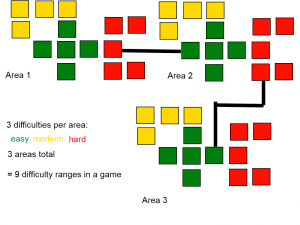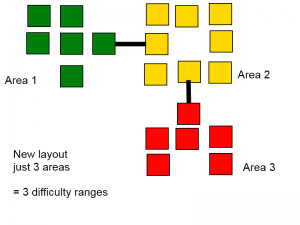We finally started completing games under the new system and so far we seem to be hitting the time goal. Unfortunately it has also become clear, especially with the difficulty range reduction, that the quests and general map systems need some heavy revisions. I was pretty resistant to admitting that I needed to sit down for another design revision session (I had hoped I was done with them), but after enough test sessions it became clear that it was inevitable. Let’s walk through all the problems that I’ve identified so far, as I haven’t really formulated solutions for them yet:
1. Not every turn is important.
This is the one pointed out by Sew and was also the one that kind of broke the camel’s back in terms of “ok, I need to deal with this” since improving this was the primary goal of the recent update. While the new systems have made significant progress in this realm, one cannot say that every turn is important. This is a tricky thing to fix in a multiplayer game since you never want to screw over a player so much from bad choices that they become irrelevant for the next 30+ minutes of the game.
At first I started thinking about this problem largely in the context of board games. I started to think that since a player only really has a couple resources to progress on (experience and gold), and that since they both feed into the same progression of total power that there aren’t really many opportunities for players to execute a strategy on the map- ultimately every space gives one of the two resources sot it’s just a matter of selecting their desired risk factor. I started to think about how many board games give players a much larger pool of resources to work with and from there specialize in as needed- giving each turn more relevance to contributing to their overarching plan. It’s certainly one way to fix the problem, but I began to realize I had my head too far up the board game metaphor. Resource allocation isn’t the only way to give importance to a turn.
Most of the subsequent problems tie into this problem, and hopefully solving them will ultimately solve this problem as well.
2. There is no danger. There is no pushing your luck.
Pretty much the staple RPG element of deciding whether to go back to town or keep going is largely absent. There is a limited amount of it present with higher risk node actions, but they lack the element of a long, grueling campaign. It’s hard to give dangerous enemies a presence when you’re only really working with one difficulty area at a time. Crushing the stat growth curve also gave us exceedingly easy enemies for rank 2/3, I need to boost them a little bit.
There’s a few different ways to handle this. Right now my main thought is on returning difficulty areas without actually increasing the size of the map. I’m also thinking about making it more difficult to unlock new areas- nodes that take multiple actions to unlock the next node or something. Not really sold on a solution for this yet.
3. There is no sense of progression, no sense of rising difficulty.
Largely tied to #2.Without more discrete difficulties it’s hard for players to appreciate their own growth.
4. Traps aren’t player’s own fault for pushing their luck too far, but mostly random bad luck.
Part of this is that I need to reconsider the purpose of traps somewhat. They were largely intended to bring a sense of danger to traversal without slogging the game down with random encounters. But with the map being so small it’s very easy for a trap to get placed somewhere that the player has no choice but to go through. Right now the obvious solution is to give players more options to manipulate traps- pay something out to reduce the trigger chance, etc. Not a total failure, it’s already kind of fun to intentionally run past a trap to raise the chance for the next sucker walking by.
5. It’s impossible to determine how hard a given main quest step will be (or anything else for that matter).
Are you noticing that like half of these problems are tied to the difficulty range reduction? It might seem like bringing it back whole sale would fix everything, but the sad reality is that many of the other problems still kind of existed to a lesser degree even when it was in place. There has to be a better way.
6. There’s no reason to engage in the main quest.
Even when players can confidently tackle the main quest line, there isn’t much reason to do so. Only the final leg of it determines the winner at the moment. There’s two competing philosophies of dealing with this: forcing players to complete it, and reward players better to complete it. Forcing players would basically have a turn timer before every objective expires. This has several useful properties: It forces players to co-operate if they aren’t able to deal with the objective solo (which is a great thing- we have stuff that inspires PvP but not as much for co-operation), it sends a clear message to players that grinding won’t fix everything (a behavior that many players automatically drift towards in an RPG, often to their own detriment), and it brings the game much closer to making sure that the 1 hour target time is always hit. The downside is that timers are a very dangerous tool since they require precise balancing in a game loaded with randomization, and a lot of players really hate timers in games. So they’re going to have to be dressed up: give a plot reason, maybe sometimes when a timer is failed it opens a new branch of the story instead of ending the game, etc.
Meanwhile we have the rewarding players option. Giving standard gold/experience rewards isn’t enough, nor is it clear. The rewards need to be unique, but not give such a huge advantage that other players can’t compete. The simplest option is granting unique equipment, items, or abilities. But I’ve been considering a more flavorful options where completing a main quest objective grants the player a special currency. This currency can then come into play in unlocking special options later in the quest. Want to convince the bad guy to stop the plan peacefully, hence skipping the boss fight entirely? Gonna need points for that. Wanna take the princess out of the dragon’s cave using stealth? Gonna need points for that. Want to save a character from dying? Gonna need points for that. It’s a somewhat dangerous line of thought since players ending up in a tight game with even points might lack the plot option they want to do. But it’s something. More than likely rewards and timers will both be used to varying degrees. It’s a matter of figuring out the right ways to do it.
And that about wraps up the current problems I’m thinking about. It felt really bad to open up a design phase again since we are so close. At some point you have to admit that the game won’t be perfect and you just need to finish the thing. And I worry that I’m taking perfection to my own grave. But I don’t think these problems will require massive code changes to implement. It’s safe for now. But at some point I have to stop altering the foundation and just get it done. At some point I have to say that it’s good enough.

